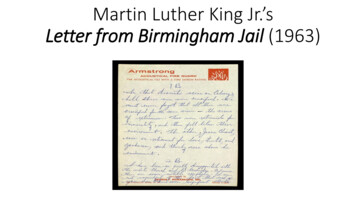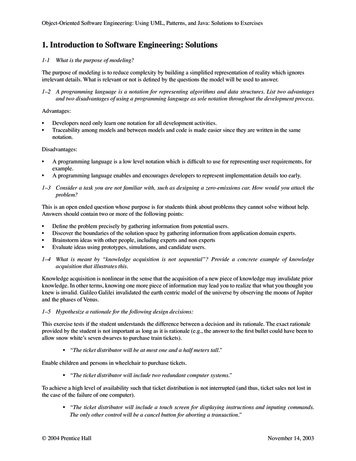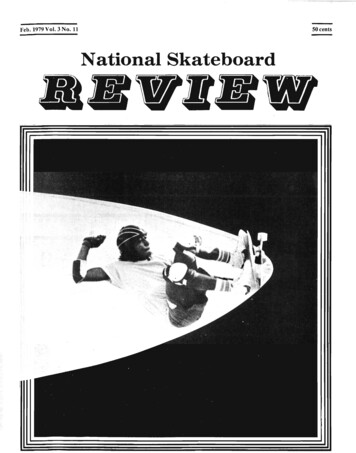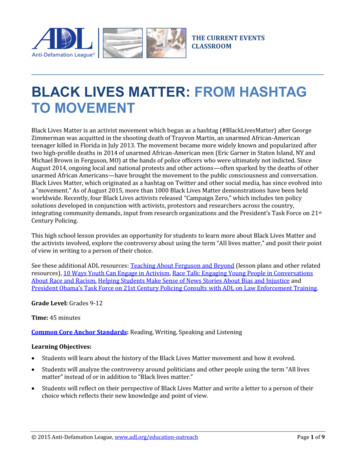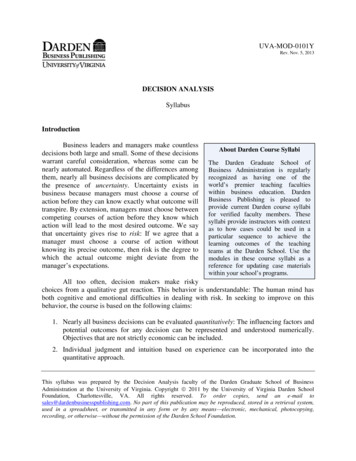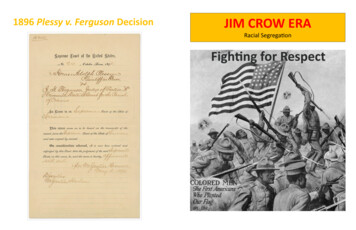
Transcription
1896 Plessy v. Ferguson DecisionJIM CROW ERARacial SegregationFighting for Respect
egated/separate-but-equal.htmlSeparate but Equal: The Law of the LandAfrican Americans turned to the courts to help protect their constitutional rights. But the courts challenged earlier civil rights legislation and handed down a series of decisions that permitted states to segregate people ofcolor.In the pivotal case of Plessy v. Ferguson in 1896, the U.S. Supreme Court ruled that racially separate facilities, ifequal, did not violate the Constitution. Segregation, the Court said, was not discrimination.The 1896-97 Supreme CourtThe members of the United States Supreme Court, 1896-97. Under Chief Justice Melville Fuller, the Court established the separate-but-equal rule. Courtesy of Supreme Court of the United States.Plessy v. FergusonIn 1890 a new Louisiana law required railroads to provide “equal but separate accommodations for the white,and colored, races.” Outraged, the black community in New Orleans decided to test the rule.On June 7, 1892, Homer Plessy agreed to be arrested for refusing to move from a seat reserved for whites.Judge John H. Ferguson upheld the law, and the case of Plessy v. Ferguson slowly moved up to the SupremeCourt. On May 18, 1896, the U.S. Supreme Court, with only one dissenting vote, ruled that segregation in America was constitutional.Jim Crow Era remains difficult to discuss andcan be painful to others.African Americans used the Great War to show their patriotism and to prove they could contribute to the protection and advancement of this country. T he National Association for theAdvancement of Colored People encouraged this spirit of Americanism to counteract racialtension and stereotypes. Because of their valorous service in protecting democracy in Europe, African-American service men began toexpect more equality in wages and job opportunities when they returned home. This ideology of advocating for social change and greater respect from white Americans, known asthe New Negro Movement, was supportedby African-American leaders such as W.E.B.Du Bois, and publicized by black newspapers.Founded in 1917 by Hubert Henry Harrison, awriter, educator and political activist from theWest Indies, the movement attracted blackwriters, poets and activists to openly voicethe need for equality.The New Negro Movement also brought increased social fears and racial tension that eruptedin the Red Summer of 1919. Some 25 race riots were reported throughout the country. Withthe end of slavery and the promises of advancement for African Americans, it was believed atthe beginning of the 20th century that white and black people could live in harmony and receive the same opportunities. Reactions after the end of World War I proved the UnitedStates had a long way to go in race relations.African Americans realized they would have to fight for racial equality on all fronts. Racismwas even experienced in the suffrage movement when African-American women like Ida B.Wells-Barnett and Alice Dunbar-Nelson supported the need for women’s voting rights. Duringan organized women’s suffrage march in 1913, the organizers of the National American Woman Suffrage Association asked black women to march separately. Although the 19th amendment was passed to grant the vote to women, it was not until the Civil Rights Movement ofthe 1950s and 1960s that African-American women could exercise this right without discriminationJim Crow Era in the United States(Courtesy of National Archives, Washington, D.C.)
United States Department of the Interiorfarm owners for a larger share of King Cotton’s profits. Landowners responded by assaulting the union’smeeting place, and ordering law enforcement officials to crush the sharecroppers. These activities led to theElaine, Arkansas, Race Riot of 1919, which destroyed agricultural unionism in the Delta and drove cotton wages back down. When African Americans in Longview, Texas, began experimenting with cooperative purchasingand marketing of farm produce—thus bypassing creditors and merchants—whites in the area launched a major assault against the black community. While the Longview Race Riot of 1919 was allegedly sparked by ablack man’s presence in a white woman’s bedroom, the NAACP and local African Americans understood thatthe violence had been sparked by the cooperative venture and growing black assertiveness. The racial dynamics exposed in the Arkansas Delta and Longview, Texas, would be repeated over and over again between 1917and 1923 as the white elite responded—sometimes with violence—to black gains by acting to reassert the status quo.Sex and Racial ViolenceOne common excuse used to rationalize racial terrorism was black male sexual violence—rape or assault—against white women. A careful study of the historical record, however, shows that alleged sexual assault wasgiven as the stated reason in only about 15 to 20 percent of all lynching incidents. In spite of the pioneeringinvestigative work of Ida B. Wells-Barnett, the NAACP, and the Association of Southern Women for the Prevention of Lynching—all of whom demolished the myth of the black rapist—racial violence is still associatedwith sexual assault in the popular mind. In At the Hands of Persons Unknown(2002), Philip Dray noted that“Wells was one of the first people in America to perceive that the talk of chivalry and beastlike blacks ravishing white girls was largely fallacious, and that such ideas were being used to help maintain a permanent hysteria to legitimize lynching, as it reinforced the notion that the races must be kept separate at all costs” (p. 64).One white North Carolinian disavowed this racial hysteria in an editorial letter that appeared in the RaleighNews and Observer on February 5, 1922:“We have a reputation of being bloodthirsty murderers down here in North Carolina, and it is our industriouslynchers who have secured that reputation for us. All this snorting about the fierce pride of the Anglo-Saxonrace is the most disgusting poppycock ever invented. If no [N]egro were ever lynched for anything but rape, itmight have some shadow of excuse. But alleged rapists constitute only a small proportion of the victims ofmobs in the south these days. Negroes are lynched for all manner of crimes, ranging down to simple misdemeanors.”The Jim Crow system did sanction one form of sexual license: white exploitation of black women. AfricanAmerican domestic workers who toiled in white households were frequently subjected to sexual assaults. Cleaster Mitchell, who worked as a domestic in Arkansas, recalled in Remembering Jim Crowthat “one time in theSouth, it’s bad to say, white men was crazy about black women. They would come to your house. They wouldattack you. They took it for granted when they saw a black lady that they could just approach her, that it wasnot an insult to her for them to approach her” (Chafe, Gavins, and Korstad 2001, p. 214). In fact, while whitesupremacists often cloaked their attacks on black communities with the excuse of black-on-white sexual violence, they understood that white men and women often initiated interracial sexual unions. In 1921 the Houston, Texas, Ku Klux Klan issued a warning to white male citizens against interracial sex.16National Park ServiceOcmulgee Mounds National Historical Park1207 Emery HighwayMacon, Georgia 31217-43995620-2020Ref.: Jim Crow EraDear Sir/Madame:The 2020 Black History Month programs presented at Ocmulgee Mounds National Historical Park will bedifferent from those done in the past. My plan is to do an interpretive program on a series of selected erasin American history associated to people of color, to enlighten and educate the public. A different programwill be presented each weekend in the month of February. The first subject to be covered is Slavery in theUnited States culminating in it’s abolishment after the Civil War. The second era to be covered is Reconstruction and the post Civil War activities of the newly freed slaves. The Third era to be covered is the periodfrom 1896 to 1955 which has been called the Jim Crow era. The next era will be the Civil Rights Era and culminating with the Equal Rights era.These series of programs relating to the historical eras of American history also included my attempt tocome up with a small pamphlet or document on each of the subjects to help the reader to better understand these periods. I realize that all of these subjects are touchy when it come to American History. It isnow time that we quit avoiding the discussion of these topics and start having meaningful dialogues as a Nation.The period known as Reconstruction was defined by the questions of race and power that Fredrick Douglassidentified, questions that flowed logically and continuously out of the Civil War. The period known as JimCrow era was the reversal of most if not all of the progress attained during Reconstruction. Ironically, thosesame questions that Fredrick Douglas asked in 1866, reverberate in many political debates today—debatesover the meaning of equal protection of the law, over the right to vote, and over the limits of presidentialand congressional authority, both in peacetime and in war. I urge all that read this document to learn asmuch as they can and not forget some of the events that defined this period.Sincerely,Lonnie J. DavisLonnie J. DavisOcmulgee Mounds National Historical ParkCultural Resources Specialist/Historian1
The Red Scare and the federal government’s campaign to uncover “agitators” reinforced white supremacyJIM CROW ERARacial Segregationand increased the likelihood of racial violence. As Department of Justice investigators bullied andinterrogated African Americans in Chicago and East St. Louis about their true reasons for coming North, thelarger public was encouraged to see black people as subversive outcasts in a virtuous “White Republic.” T hemainstream media fueled the fire of anti-black racism by publishing sensational headlines such as: “NegroesFlock in from South to Evade Draft” (St. Louis Times), “North Does Not Welcome Influx of South’sOverviewNegroes” (Chicago Herald), “Negro Migration: Is It a Menace?” (Philadelphia Record), and “Negro Influx On,Jim Crow Era in United States history refers to the years from the end of Reconstruction in 1877 to thebeginning of the Civil Rights movement in the 1950s. The term Jim Crow predates the Civil War. JimCrow was the name of a fictional character depicted as an unintelligent, foolish caricature of a black slave.This character was played by the white actor Thomas Dartmouth “Daddy” Rice in blackface makeup inminstrel shows in the early 1830s. Rice claimed to have gotten the name from a real life occurrence wherehe heard an older black man singing a song called “Jump Jim Crow,” which Rice then appropriated for hisminstrel show. In the 1800s, the popularity of these shows across the country turned the name JimCrow into an ethnic slur against black people. Beginning in 1877, segregation and disenfranchisement lawsthat was enacted by southern states became known as Jim Crow Laws. Jim Crow laws represented a formal,codified system of racial apartheid that dominated the American South for three quarters of a century untilthey were systematically challenged in the 1950s.Plan to Dam It” (Newark [N.J.] News) (Gregory 2005, p. 47.)Rising postwar unemployment and inflation added fuel to the competitive fire. The race riots that broke outin East St. Louis (1917) and Chicago (1919) occurred in the wake of failed strikes as well as stillborn attemptsto create multiracial trade unions. As corporations and their organizations methodically destroyed the mostimportant vehicle for collective working-class economic improvement—unions—a sense of anger anddesperation swept through urban neighborhoods. As competition between workers intensified, racialtensions flared anew. The economic dimensions of the riots cannot be overestimated.Segregation and the Race RiotsThe race riots of 1917 to 1923 occurred during the era of legal segregation (or Jim Crow as it was commonlycalled). Segregation was designed to generate chronic interracial strife and distrust. Why was thesegregation era marked by so much violence and so many race riots? Segregation—like slavery—was alabor system designed to extract surplus labor power, property, tax revenue, wealth, and economicopportunities from African Americans and redistribute these resources to the dominant society. “ Raceprejudice,” the sociologist Oliver C. Cox observed, “is a social attitude propagated among the public by anexploiting class for the purpose of stigmatizing some group as inferior so thatthe exploitation of either the group itself or its resources or both may bejustified” (Cox 1948, p. 393).Industrial and agricultural employers were the major beneficiaries of this racialwealth redistribution, and they treated black workers’ efforts to organize oreven assert themselves in their workplaces with repressive measures. Convictlabor, debt peonage, and the chain gang may be seen in this context asinstitutionalized forms of economic—and often physical—violence.Thus, when African Americans attempted to seize the opportunities offered bythe improved economic climate of the early war years, it was not hard topredict that employers would react in a visceral manner. As African AmericansConvict Labor(Photo: State Archives of Florida)began to leave the South in large numbers in 1916, state and local authorities in some areas ordered policeforces to try to halt the exodus. African-American workers in Macon, Georgia, and Jacksonville, Florida,among other towns, were beaten and driven away from train stations. African-American sharecroppers inthe Arkansas Delta began organizing an agricultural labor union as well as challenging large215
It is important to place these riots in historical context. In terms of lives lost per capita, these riots were farbloodier than the 1960s race riots but not as deadly as the anti-black riots of the nineteenth century. Ineach of the major race riots between 1917 and 1923—with the partial exception of the Houston Race Riotof 1917—the instigators and perpetrators of violence as well as property destruction were white citizens.This does not mean that white people in the United States were somehow biologically or culturallypredisposed to violence. Instead, white rioters were acting on behalf of perceived pressures, interests, andideologies. It is necessary to examine the roots of white violence in order to understand the genesis of therace riots. The savagery of the riots, the losses African-American communities suffered, and the effects onrace relations between whites and blacks continue to echo down into the twenty-first century.Global ContextW. E. B. Du Bois, A. Philip Randolph, and other African-American leaders believed that the social forcesunleashed by World War I would help blacks challenge the system of white supremacy in the United States.In addition, a number of industrial labor union organizing committees undertook major interracialunionizing campaigns in Chicago, Birmingham, and other urban areas. T he most powerful unions hadtraditionally operated with color bars that excluded African Americans, Chinese, and others. Black workers,however, responded with guarded optimism to organizers’ efforts to build interracial locals. James WeldonJohnson sensed a revived spirit of hope among African Americans as he traveled throughout the countryduring the war:“I was impressed with the fact that everywhere there was a rise in the level of the Negro’s morale. Theexodus of Negroes to the North was in full motion; the tremors of the war in Europe were shakingAmerica with increasing intensity; circumstances were combining to put a higher premium on Negro muscle,Negro hands, and Negro brains than ever before; all these forces had a quickening effect that was runningthrough the entire mass of the race. “(Johnson 1933, p. 315)It was not long, however, before the forces of reaction regained the upper hand. Anticolonial andrevolutionary movements were defeated, many by military force. In the United States, fear of workingclass and black militancy led to a right-wing political backlash known as the “Red Scare.” J. Edgar Hoover,the attorney general Alexander Mitchell Palmer, and others used their authority to arrest, detain, andultimately expel thousands of “alien” political activists. As “law and order” types such as Hoover gainedascendancy, spaces for social and economic justice organizing diminished rapidly. State and federalauthorities used powers gained through the Espionage Act of 1917 and the Sedition Act of 1918 to disruptlegitimate protest groups while ignoring the real crimes that worsened racial tensions. For example, in thetwo years leading up to the Chicago Race Riot of 1919, scores of African-American homes were bombed,and yet state authorities conducted no meaningful investigations nor were any of the perpetrators everfound. When similar bombing attacks rocked black homes in Miami, Florida, undercover federal agentsappeared more interested in spying on African Americans than in catching the guilty parties. In contrast,the African-American soldiers who were involved in the Houston Race Riot of 1917 were vigorouslyprosecuted and nineteen were executed.OriginsPrior to the Civil War the inferior status of slaves had made it unnecessary to pass laws segregating themfrom white people. Both races could work side by side so long as the slave recognized his subordinate place.In the southern cities, where most free blacks lived, rudimentary forms of segregation existed prior to 1860,but no uniform pattern emerged. In the North free blacks also labored under harsh restrictions and oftenfound an even more-rigid segregation system than in the South.You would have expected the Southern states to start creating a segregation system immediately after theCivil War, but that did not happen. In some states the legislatures imposed rigid separation, but only incertain areas; Texas, for example, required that every train have one car in which all people of color had tosit. The South had no real system of public education prior to the Civil War, and as the postwargovernments created public schools, those were as often as not segregated by race. Nonetheless, NewOrleans had fully integrated schools until 1877, and in North Carolina former slaves routinely sat on juriesalongside whites.In 1877 the Supreme Court ruled in Hall v. DeCuir and in this case it was ruled that states could not prohibitsegregation on common carriers such as railroads, streetcars, or riverboats. In the Civil Rights Cases of1883, the court overturned key elements of the Civil Rights Act of 1875, thereby sanctioning the notion of“separate but equal” facilities and transportation for the races (though it did not use the term separate butequal). Seven years later the court approved a Mississippi statute requiring segregation on intrastatecarriers in Louisville, New Orleans & Texas Railway v. Mississippi (1890). As those cases demonstrated, theSupreme Court essentially concurred in the South’s “solution” to the problems of race relations.From 1887 to 1892 nine states, including Louisiana, passed laws requiring separation on public conveyances,such as streetcars and railroads. Though they differed in detail, most of those statutes required equalaccommodations for black passengers and imposed fines and even jail terms on railroad employees who didnot enforce them. Five of the states also provided criminal fines or imprisonment for passengers who triedto sit in cars from which their race excluded them. The Louisiana Separate Car Act passed in July 1890. Inorder to “promote the comfort of passengers,” railroads had to provide “equal but separateaccommodations for the white and colored races” on lines running in the state.Challenging the Separate Car ActThe Louisiana Separate Car Act marked a dramatic and humiliating reversal of fortune for the black andmixed-race citizens of Louisiana. Although a slave state before and during the Civil War, Louisiana in generaland New Orleans in particular had always had, because of their French origins, a more-tolerant attitudetoward people of color than the other Deep South states. In addition to the usual demarcation betweenblack and white, since the 1700s New Orleans had acknowledged a third class, free people of color (inFrench, gens de couleur libres), sometimes called Creoles, the freed descendants of European fathers andAfrican mothers who had enjoyed a great deal of autonomy.Although Louisiana, like most Southern states, had laws against marriage between slaves, it did allow free143
people of color, whites, and the gens de couleur to marry, testify in court against whites, and in some casesinherit property from their fathers. Some became slave owners themselves, and apparently many of themaccumulated significant property. Their social standing, especially in New Orleans, had insulated them fromsome of the white reaction following the war. But when whites regained power after the end ofReconstruction, they saw only two races, and the privileged position of the gens de couleur evaporated;from that point forward they were black as far as the law was concerned.Gens de couleur helped form the American Citizens Equal Rights Association when the Separate Car bill wasintroduced and they pledged to fight it. Among the members of the committee was Louis A. Martinet, aCreole attorney and doctor who had also founded the “Daily Crusader”, and he and his newspaper becamethe leading opponents of the law. After the law’s passage, his paper called for both a legal challenge anda boycott of those railroads that had segregated cars. Martinet received the help of Albion W. Tourgée, awhite lawyer, who had fought for the North during the Civil War, and served as a lawyer and judge in NorthCarolina.A citizens’ committee (the Citizens’ Committee to Test the Constitutionality of the Separate Car Law), drawnprimarily from the Creole community, raised 3,000 to fund a lawsuit, and Tourgée agreed to belead counsel in the case. But they also needed a local lawyer, since the challenge to the law would have togo through state courts before it could be appealed to the federal system. A white lawyer, James Walker,finally agreed to take the case in December 1891. Martinet did not consider any of the black lawyers in NewOrleans competent to raise a constitutional question, since, as he explained, they practiced almost entirelyin the police courts.Tourgée and Martinet considered several possibilities. One of those was that they could have a blackpassenger buy a ticket outside Louisiana and then travel into the state, thus raising a challenge to the lawunder the commerce clause. Another was that they might have a fair-skinned person of mixed race attemptto enter the ladies’ car, but there they ran into the problem, as Martinet noted, that she might not berefused admission.In New Orleans, he wrote to Tourgée, “People of tolerably fair complexion, even if unmistakably colored,enjoy here a large degree of immunity from the accursed prejudice.” But Tourgée wanted someone whowas an octoroon, a person who was “of not more than one eighth colored blood,” because he believed thewinning strategy would be to expose the haziness in the definition of race. Did the law give the authority toa train conductor to determine the race of a passenger? “It is a question,” Tourgée told his colleague, thatthe Supreme Court “may as well take up, if for nothing else, to let the court sharpen its wits on.”Martinet agreed, and in New Orleans he began talking to sympathetic railroad officials who wanted the lawoverturned for their own financial reasons. It would not do if their test passenger was merely excluded fromboarding or even thrown off the train; he would have to be arrested so that a real case existed and he couldclaim injury in federal court. One railway informed him that it did not enforce the law, while another saidthat though it opposed the statute as too costly, it did not want to go against it publicly. Then the Louisville& Nashville line agreed to a test case. As it happened, for reasons neither Martinet nor Tourgée expected,their test case fizzled.4Meanwhile, large numbers of black southerners were moving to the North in order to take factory jobs inthe burgeoning war economy. By the time thousands of black World War I veterans returned from Francedemanding their civil rights, the NAACP was becoming a mass-membership protest organization withhundreds of new branches forming in the South and Midwest. African Americans in Florida organized thefirst statewide civil rights movement of the century, and black voters began to flex their political muscles inChicago, East St. Louis, New York, and other cities. Many white citizens, however, interpreted blackadvancement as threatening their own interests. The leadership of the Democratic Party in Miami, Florida,responded to African-American voter registration with an ad that stated white supremacy was beingassaulted which was published in the Miami Herald.Race riots broke out in Washington, D.C.; Charleston, South Carolina; Tulsa, Oklahoma and Long-view, Texas,among other places. Lynching was also prevalent during these years. Eleven African-American men wereburned alive at the stake in 1919. In the same year lynch mobs murdered sixty-nine black people, includingten World War I veterans whose military service was viewed by some whites as a threat to the racial statusquo. Anti-black race riots were often waged over the course of several days, and garnered internationalattention. The riots cost hundreds of lives and incalculable property damage. The riots also undermined thepolitical and economic status of African Americans in numerous communities across the nation.The intensity of these riots may be explained in part by examining the social context of violence in thisperiod. White rioters enjoyed an almost universal immunity from prosecution, whereas their blackcounterparts were often incarcerated for defending their homes and neighborhoods. White citizens whoshot or beat a black person to death in broad daylight had little to fear from law enforcement authorities,who in many case often participated in vigilante activities themselves.Race riots were not inspired by blind racist hatred. White citizens who rioted were motivated by politicaland economic, as well as social, factors. For example, the 1920 Election Day massacre of African Americanswho attempted to vote in Orange County, Florida, was designed to enforce black disfranchisement. The EastSt. Louis Race Riot of 1917 was aimed in part at keeping African Americans from moving up the occupationalladder. The Tulsa, Oklahoma, Race Riot of 1921destroyed a thriving black business district, andwhite rioters explicitly targeted properties ownedby African Americans. Remembering the yearsshe spent building up a successful hairdressingpractice in Tulsa, Mabel Little recalled decadeslater, “At the time of the riot, we had ten differentbusiness places for rent. Today, I pay rent” (Hirsch2002, p. 8). Riots in small towns and rural areasdrove African Americans off the land and oftenallowed white residents to take control of blackproperty for drastically reduced rates or fornothing at all. The massacre and forced removalof the African-American community in Rosewood,Florida, in 1923 wiped out generations of blackRosewood, Florida ruins in 1923land ownership.(Courtesy : Bettmann/CORBISS)13
On February 24, 1892, 21-year-old Daniel Desdunes purchased a first-class ticket on the Louisville &Nashville from New Orleans to Mobile, Alabama, and took a seat in the “whites-only” car. He was arrestedaccording to the plan and charged with a criminal violation of the Separate Car Act. Tourgée, Martinet, andthe local attorney, James Walker, filed a “plea of jurisdiction,” arguing that since Desdunes was a passengerin interstate commerce, he had the right and privilege to travel free from any governmental regulation savethat of the Congress. Tourgee also introduced his claim that the determination of race was a complexquestion of both science and law and so could not be delegated to a train official. The lawyers assumedthat their plea would be denied, Desdunes would be convicted, and then they would appeal. Then, onApril 19, 1892, the presiding judge, Robert Marr, suddenly disappeared, and no one knew what hadhappened to him.While Desdunes’s attorney tried to figure out what to do next, on May 25 the Louisiana Supreme Courthanded down its decision in Louisiana ex rel. Abbott v. Hicks. A train conductor on the Texas and PacificRailway had been prosecuted for seating a black passenger in a white car, and the railway argued that sincethe passenger was traveling between two states, either the Louisiana law did not apply to interstate travelor, if it did, then it was unconstitutional under the commerce clause. Much to everyone’s surprise, theLouisiana high court agreed that regulations of the Separate Car Act could not apply to interstatepassengers. Given that development, the new judge in Desdunes’s case, John Ferguson, dismissed the case.Homer Plessy and Jim Crow"Colored Troops", returning from fighting in the Great War(Photo: Library of Congress)rude awakening upon their return. Back home, many whites feared that African Americans would returndemanding equality and would try to attain it by employing their military training. As the troops returned,there was an increase of racial tension. During the summer and fall of 1919, anti-black race riots erupted intwenty-six cities across America. The lynching of blacks also increased from fifty-eight in 1918 to seventyseven in 1919. At least ten of those victims were war veterans, and some were lynched while in uniform.Jami L. Bryan, Army Historical Foundatio
Overview Jim Crow Era in United States history refers to the years from the end of Reconstruction in 1877 to the beginning of the ivil Rights movement in the 1950s. The term Jim row predates the ivil War. Jim row was the name of a fictional character depicted
